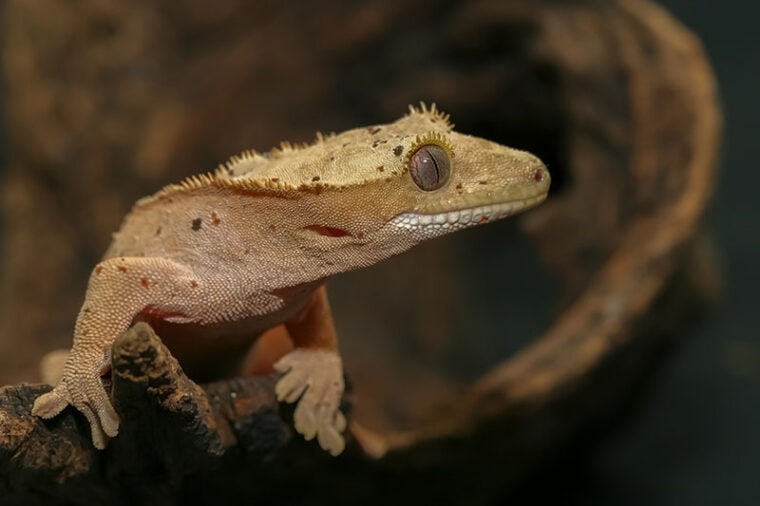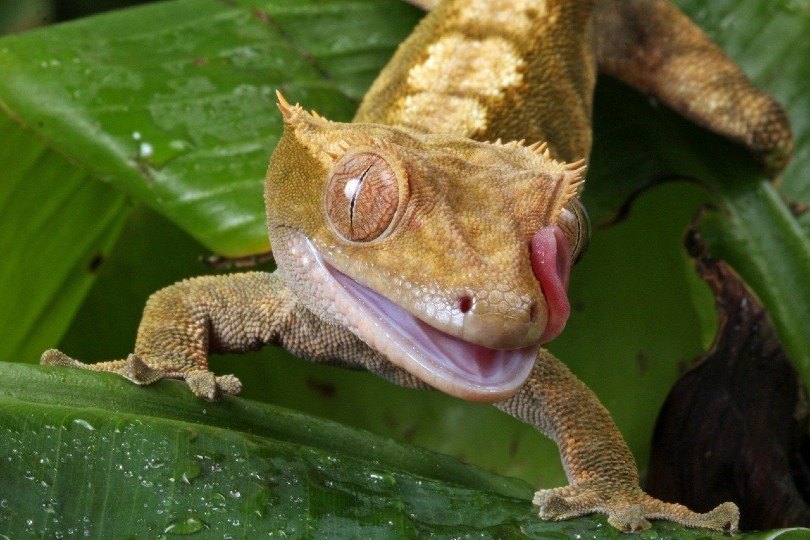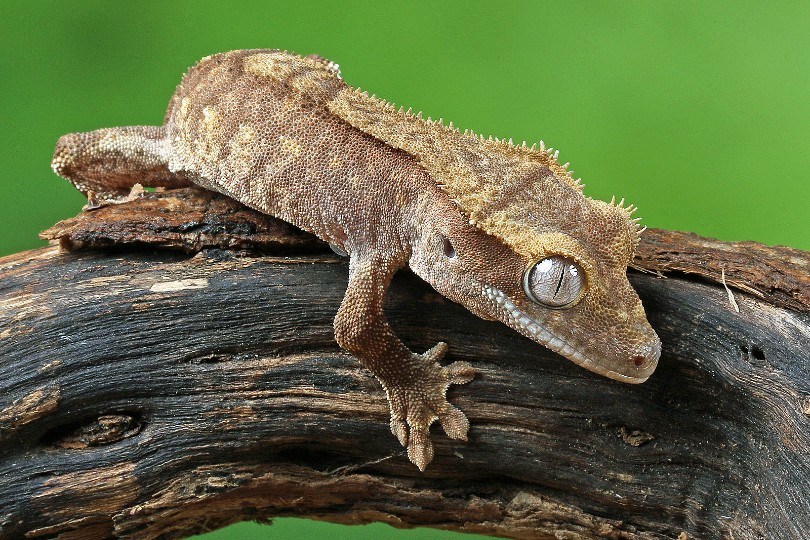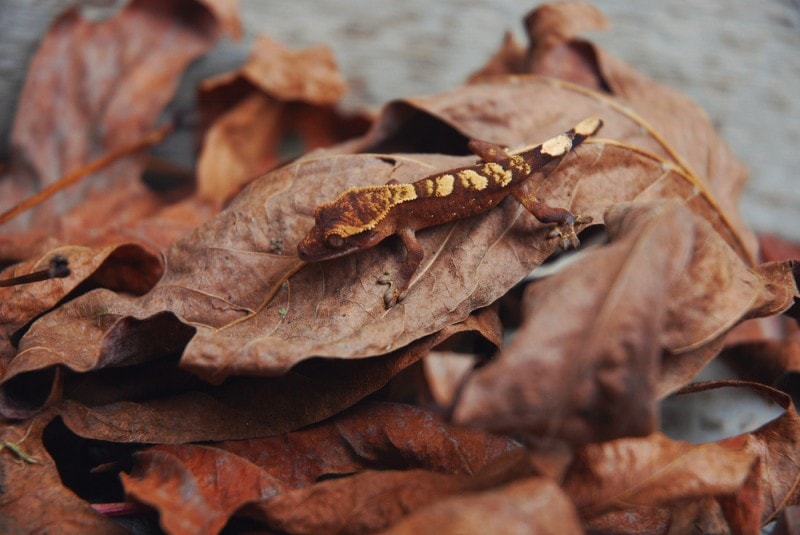
[ad_1]

Shedding is a normal part of a healthy crested gecko’s life. All crested geckos will shed, and babies will shed more than others because they are still growing. How often a crested gecko sheds depends largely on its current growth rate, which varies throughout its life.
It’s important to monitor how often your crested gecko is shedding and ensure the process goes smoothly. While shedding is completely normal, many complications can arise (usually due to an improper diet or environment).
These problems are preventable, especially if they are caught early.

How Often Do Crested Geckos Shed?
Crested geckos shed about every 2–4 weeks as adults. Around 3–4 years old, a crested gecko’s growth rate will slow even more, and they may only shed once a month.
However, younger crested geckos will shed much more as they grow faster. You can expect frequent shedding during the first 6–12 months of a gecko’s life. Most growing geckos will shed multiple times a week.
Once the gecko approaches adolescence, they will reduce their shedding to only a few times a week. This amount will slowly lower as the gecko approaches adulthood.
Keep in mind these frequencies don’t change overnight. Most geckos have the fastest growth rate when they’re newborns, and then this growth rate reduces as they get older. Therefore, their shedding frequency decreases at a somewhat even rate until they’re around 4 years old.

Other Factors That Affect Shedding Frequency
On top of age, some other factors may have a minor effect on how often your crested gecko sheds:
- Gender: Males and female crested geckos grow at different rates. Males tend to be larger, which means they usually grow faster. For this reason, they may shed more as babies and continue to shed frequently for longer into adulthood.
- Environmental conditions: Temperature and humidity will affect how often a crested gecko will shed. These factors should be perfect so your lizard is shedding just as much as they need to—no more, no less. A dry enclosure can prevent your gecko from shedding as much as they need to, leading to health problems.
- Nutrition: As you might guess, crested geckos can only grow if fed properly. Those without proper nutrition may not grow as they should and, therefore, may not need to shed as much.
- Illness: Some illnesses affect how often a gecko will shed. For instance, adults will shed in an attempt to control external parasites. If your gecko is infected, they may shed their skin more often.

How Long Does Shedding Take?
Crested geckos shed extremely quickly. It should only take around 15 to 30 minutes for them to shed. You may not even see it happen as they often shed and consume their skin at night.
If your crested gecko is struggling, you may notice pieces of dead skin still stuck on them in the morning. Any stuck skin can cause health problems1, especially if wrapped around a body part. Geckos can lose toes and part of their tail due to dead skin becoming stuck and cutting off blood flow.
Geckos with stuck skin need to be seen by a vet, preferably. There is often an underlying reason for the stuck skin, and the vet must determine the underlying cause. In the meantime, you can provide your gecko with a bath to help the dead skin come off.
Keep the bath warm and shallow to prevent the gecko from drowning. Geckos can swim (sometimes), but it is better to think of this as a soaking bath than a swimming pool. Keep the water warm and add more water as it cools. Of course, don’t add scorching hot water, as this can overheat your gecko.
You should never remove the skin yourself. Stuck skin adheres to the healthy skin underneath. Pulling it off can cause damage and potentially make the problem even worse.


How to Tell When a Crested Gecko Is About to Shed
Because you may not see your lizard shed, you likely want to keep an eye on your lizard for signs that they’re about to shed. This helps you judge how often your lizard is shedding, which indicates their overall health.
Usually, crested geckos turn a different color when they’re about to shed. They may appear paler or ashy. Sometimes, their skin may darken. This is because the old skin becomes transparent as it separates from the new. You may not see the detailed markings your gecko once had (though they will reappear after the gecko sheds). Their skin may get drier as it prepares to fall off, too. It may look dry, or you may notice that it feels dry.
Sometimes, crested geckos may have a harder time climbing the walls of their enclosure and sticking to stuff. However, this sign is usually paired with other signs, like dullness and dryness.
Geckos may become itchy and uncomfortable right before a shed. They may rub against objects inside the enclosure to scratch. However, this behavior occurs often during a shed, when you’re probably sound asleep.
Signs of a Healthy Shed
If you do notice that your crested gecko is shedding, there are several signs you can look out for that indicate their shed is healthy. Healthy sheds don’t need to be interfered with, while unhealthy sheds may warrant a vet appointment. Therefore, it’s important to know the difference.
Healthy sheds only take a few minutes, and the skin should come off in one piece or several very large pieces. If the shed is incomplete or torn, it’s possibly a sign that something isn’t going well.
After shedding, the crested gecko should appear bright and vibrant. If the new skin also looks discolored or dull, it may indicate health problems. The geckos’ behavior should return to normal after the shed.


Conclusion
Crested geckos shed regularly. They often shed at night in only a few minutes, so their owners typically won’t notice that they shed at all. However, there are many signs that your crested gecko is about to shed that may pop up 24 hours before. You can use these signs to determine how often your gecko is shedding.
How much your gecko sheds depends on their age. Younger geckos are growing more and will shed more.
Shedding can lead to some health problems, however, it’s a very normal and healthy process. Problems usually only occur when there is an underlying issue, such as insufficient humidity.
If you notice that your crested gecko isn’t shedding properly, it’s important to contact your vet and figure out the underlying reason for their difficulty.
Featured Image Credit: Krisda Ponchaipulltawee, Shutterstock
[ad_2]
Source link

